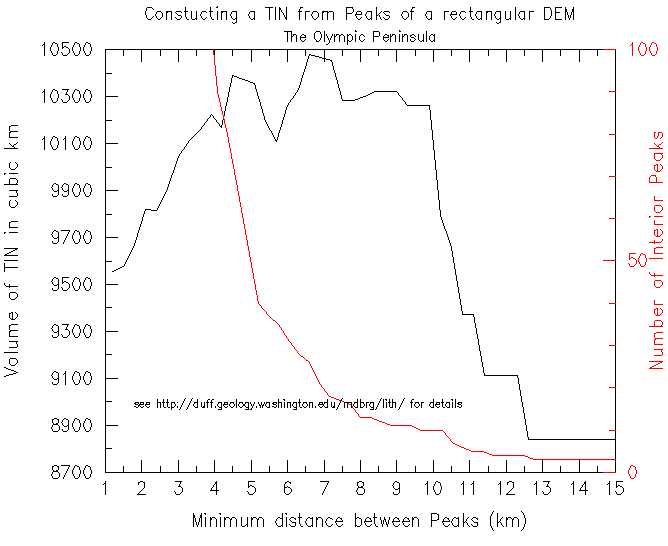valley cross-sections:
sections.ps7412621 bytes
sections.tif3197352 bytes
Valley incision and the uplift of mountain peaks
When valleys are deepened, the reduced weight of the contintental mass
causes the landscape to float upward. (see Montgomery, D. R., Valley
Incision and the Uplift of Mountain Peaks, Journal of
Geophysical Research, v. 99, No. B7, p. 13,913-13,921, 1994.)
We are now looking at this effect in the the Olympic Mountains of northwest
Washington State, using automated processing of the current elevation, as
measured on a 30m lattice.
We cannot say how much surface has been eroded from above the present peaks,
but we can drape a surface over the present peaks and postulate that it is
a lower limit on the bulk of the original rock mass.
Algorithms were devised to select the area of analysis and to select elevation points on the edges and interior of the study area.
As we varied to radius parameter, varying the number of peaks used to represent the mountains, our raw volumes varied as shown:

We chose a radius of 6.6 km, which yields the maximum raw volume of
However, a number of current peaks protrude above this TIN, moreso with this radius than with a smaller radius. We created a lattice of the difference,
and selected those points whcih were maxima (that is, maximum elvation
above the original TIN) within a radius of 2.4 km. This increased the mean
elevation of the study area from 1305 meters to 1364 meters. This surface
covers nearly all of the current landscape surface; the mean of the current
surface that protrudes above the valley surface averages to 121 mm.

Here is the slope distribution within 10km-square blocks.
All this appears in
Montgomery, D. R., and Greenberg, H. M., Local relief and the height of Mount Olympus,
Earth Surface Processes and Landforms, v. 25, p. 385-396, 2000.


